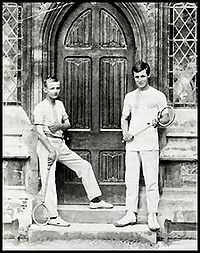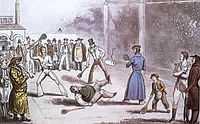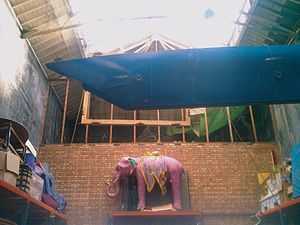Rackets (sport)

Rackets (British English) or racquets (American English) is an indoor racket sport played in the United Kingdom, United States, and Canada. The sport is infrequently called "hard rackets," possibly to distinguish it from the related sport of squash (formerly called "squash rackets").
Manner of play


Rackets is played in a 30 by 60 feet (9.1 by 18.3 m) enclosed court, with a ceiling at least 30 feet (9.1 m) high. Singles and doubles are played on the same court. The walls and floor of the court are made of smooth stone or concrete and are generally dark in colour to contrast with the white ball. A player uses 30.5 inches (770 mm) wooden racket, known as a bat, to hit a 38mm (1.5 inch) hard white ball weighing 28 grams. Currently there are only two companies in the world producing rackets bats: Grays of Cambridge (UK) [1] and Harrow Sports (US), in Denver, Colorado. A good stroke must touch the front wall above a 26.5 inches (670 mm) high wooden (often cloth-covered) board before touching the floor. The ball may touch the side walls before reaching the front wall. The player returning a good stroke may play the ball on the volley, or after one bounce on the floor. The play is extremely fast, and potentially quite dangerous. Lets (replayed points) are common, as the striker should not play the ball if doing so risks hitting another player with it. Matches preferably are observed by a "marker," who has the duty to call "Play" after each good stroke to denote that the ball is "up." Games are to 15 points, unless the game is tied at 13-all or 14-all, in which case the game can be "set" to 16 or 18 (in the case of 13-all) or to 15 or 17 (in the case of 14-all) at the option of the player first reaching 13 or 14. Only the server can score — the receiver who wins a rally becomes the server. Return of service can be extremely difficult, and, in North America, only one serve is allowed. Matches are typically best of 5 games. If an opponent is cleanswept 15-0 15-0 15-0,(or in the more common terminology "Joplinged" - a term that originated from the name of a player who failed to win a point in every competition game he played) it is customary for the defeated player to buy drinks for all those who spectated. The most recent notable example is Steve Tulley in the Neptune Professional Singles 2014.
The main shots played are the volley, forehand and the backhand all similar to the way one plays these in squash, however, there is one unique shot called the "zackhand" Where one hits a forehand into the side wall of the backhand side.

Because the game of squash rackets (now known as 'squash') began in the 19th century as an off-shoot of rackets, the sports were similar in manner of play and rules. However, the rules and scoring in squash have evolved in the last hundred years or so. Rackets has changed little; the main difference today is that players are now allowed brief rest periods between games. In the past, leaving the court could mean forfeiting the match, so players kept spare rackets, shirts and shoes in the gutter below the telltale on the front wall.
The governing bodies are the Tennis and Rackets Association (UK) and the North American Racquets Association.
History

Rackets began as an 18th-century pastime in London's King's Bench and Fleet debtors prisons. The prisoners modified the game of fives by using tennis rackets to speed up the action. They played against the prison wall, sometimes at a corner to add a sidewall to the game. Rackets then became popular outside the prison, played in alleys behind pubs. It spread to schools, first using school walls, and later with proper four-wall courts being specially constructed for the game. Some historians assert that the game was codified through its popularity at the Harrow School in London, where it was played as early as the second half of the 18th century.
Eglinton Castle has a 'Racket Hall' which is first shown on the 1860 OS map, but estate records show that it was built shortly after 1839, the first recorded match being in 1846. The floor is of large granite slabs, now hidden by the wooden floor. It is the very first covered racket court and is now the oldest surviving court in the world, as well as being the oldest indoor sports building in Scotland. It has been restored as a racket hall, but used as an exhibition area.[2]

Some private clubs also built courts. Along with real tennis and badminton, rackets was used as an inspiration for the game of lawn tennis, invented in 1873 by Walter Clopton Wingfield. A vacant rackets court built into the University of Chicago's Stagg Field served as the location of the first artificial nuclear chain reaction on December 2, 1942. The Stagg Field court is often mistakenly identified as having been a "squash rackets" court. Rackets was part of the 1908 Summer Olympics program.
The Book of Racquets was published by J. R. Atkins in 1872 and is a good guide to the game. It was reprinted to commemorate the 1981 World Rackets Challenge Match between W. J. C. Surtees and J. A. N. Prenn as a limited edition of 250 copies.[3]
Court locations
United Kingdom
There are about twenty courts in some of the major public schools and private clubs in the United Kingdom.
Schools
- Charterhouse School – 2 courts
- Cheltenham College
- Clifton College – recently refurbished for the world championships
- Eton College – 2 courts
- Haileybury
- Harrow School – 2 courts
- Malvern College – 2 courts
- Marlborough College – 2 courts
- Radley College
- Rugby School – 2 courts
- St Paul's School (London)[4]
- Tonbridge School – 2 courts
- Wellington College
- Winchester College – 2 courts
Clubs
- BRNCC Dartmouth
- Hayling Island
- Manchester Tennis & Racket Club (2)
- Queens Club, London (2)
- RMA Sandhurst
There are also private clubs that the public may join, and a nomadic club, The Jesters.
North America
There are eight active courts in North America, all at private clubs:
- The Racquet Club of Chicago has 2 courts. Opened in 1924, with a Court Tennis and two double squash courts. The courts are in exceptional condition, and have hosted the prestigious Western Open and other tournaments multiple times. The lobby of the courts contains plaques with the names of yearly winners going back to 1924. This club is open to both Men and Women and features many other gym facilities. It is known as one of the most exclusive clubs in the Chicago area.
- (A rackets court underneath the now-demolished west stands of the original Stagg Field at the University of Chicago was the site of the world's first nuclear reactor CP-1)
- The Detroit Racquet Club opened in 1902, designed by the noted architect Albert Kahn. Constructed by Joseph Bickley. Originally open to the air with natural lighting until it was glazed over with lights added in 1912. During the 1980s the club was using the court as a volleyball court until a restoration of the sport was initiated with a new group of younger members. This court has a very large gallery with many tiers of seating and standing room. Detroit Racquet Club is the smallest Rackets club on a world circuit with less than 80 members.
- The New York Racquet and Tennis Club opened in 1918 on Park Avenue, the building designed by Mckim, Mead and White. The building originally housed two courts: one was converted to a double squash court in 1956. It is one of the remaining large clubs with a male only policy.
- Opened in 1902. The Tuxedo Park courts are part of a large private gated community which hosts many tournaments bringing in players from all around the world.
- Opened in 1907 with two courts, one of which now has been converted to a double squash court, at The Racquet Club of Philadelphia.[5]
- Boston Tennis and Racquet Club
- Opened in 1902, with one rackets, one court tennis, and six North American squash courts, it was the original site of the Boston Athletic Association which now orchestrates the Boston Marathon; after late 1990's structural renovation, three international squash courts have displaced three of their narrower counterparts.
- Opened in 1889, the court was constructed four feet longer and two feet wider to facilitate doubles play. It was resized to regulation 60 by 30 feet in 1909.
Yearly, North American clubs host a male guest from British boarding schools known as a "fellow" who usually is between the age of 18 and 19. The fellow program lasts three to four months. The fellowship program allows young men from Britain to experience the United States clubs (there is an active court in Montreal). Normally these men travel to all the North American clubs to play in tournaments. Their duties include being an unpaid teacher of the sport to wrapping and trimming Rackets balls.
Disused, lost or converted courts
County Carlow - Still in daily use as part of Carlow Sports and Social Club.| Country | Name | City | Information |
|---|---|---|---|
| USA | The University Club | Detroit, Michigan | The last court built in North America, constructed by Joseph Bickley. This building has now been demolished to make way for a McDonalds |
| The Tavern Club | Cleveland | 36th and Prospect Avenue, Cleveland, Ohio, USA. Now houses a doubles squash court. | |
| The Pittsburgh Athletic Association | Pittsburgh | 5th Avenue, Pittsburgh, Pennsylvania, USA. The court now houses three squash courts installed laterally, making use of the original walls of the hard rackets court. The marker's gallery is still present. | |
| St Louis Racquets Club | St Louis | Now houses a doubles squash court. | |
| Lakewood | New Jersey | Now used as a student lounge, adjacent to the refurbished real tennis court. | |
| UK | Devonshire Park | Eastbourne, Sussex | Built in 1875, this court is now used as a prop store for the Devonshire Park Theatre. A section of the front wall has been bricked up and used as a ladies' toilet for the pub next door. This court could be converted back for play.
|
| Belmont House | Wraxall | This is in Bristol. Built in the 1860s by Williams Gibbs, who made his fortune out of guano – bird droppings imported from the Pacific, a popular Victorian garden fertilizer. It passed through the family and was last owned by the second Lord Wraxall. This court has now been lost. Sections of it have been taken to be part of the main house and the remaining is to be converted into a theatre. | |
| Copped Hall [6] | Epping | This is in Essex. The main house is under restoration. The rackets court has now been converted into a tea rooms; the gallery still remains.
| |
| Park Place Estate | Henley-on-Thames | Built in 1900, it is at the moment in disrepair. Plans were afoot to restore it to its former glory, but its future is now unsure. | |
| Eglinton Castle | Kilwinning, Ayrshire, Scotland | Built in 1842 and refurbished c. 1985 as an exhibition hall. | |
| Fyvie Castle | Scotland | Fyvie Castle was built in 1903. Restored and used as a playhouse / exhibition space. | |
| Stonyhurst College, | Clitheroe, Lancashire | Converted to squash courts in 1933. | |
| Newcastle University | Newcastle upon Tyne, Northumberland | Part of the University Building, was being used for play as late as the 1980s. Its future is now unsure. Now used for ping pong. | |
| Kinloch Castle | Rum, Scotland | ||
| Rossall School | Lancashire | Converted to squash courts. | |
| Royal Naval College | Greenwich | These two courts were built in 1874, converted to squash courts in 1882, and now converted into an exhibition space. | |
| Stonehouse, Plymouth | Millbay | Converted to squash courts in 1930s. | |
| Samsome Walk | Worcester | Converted to apartments. | |
| Ireland | Leinster Lane | Dublin | Now used as a book archive for the National Library of Ireland. |
| Trinity College | Dublin | Now used as a bookstore and possibly to be absorbed in new building development. | |
| Dawson Street | Dublin | Now used as a car park, including vehicle lift. | |
| Carlton House | Maynooth | Believed absorbed in current commercial development. | |
| Curragh Camp | County Kildare | Converted to squash courts. | |
| Gibraltar | Now converted into a Squash Club. | ||
| Australia | Melbourne Club | Melbourne | Converted into squash courts 1913. |
| Pakistan | Kuldana Cantonment, Murree Hills | Pakistan | Built in 1897, still standing, now a gymnasium. |
| India | Calcutta Racket Club | Calcutta | Converted to squash courts in the 1930s. |
Tournaments


The world championship for singles (and doubles) is decided in a challenge format. If the governing bodies accept the challenger's qualifications, he plays the reigning champion in a best of 14 games format (best of 7 games on each side of the Atlantic). If each player wins seven games, the total point score is used as a tie breaker. The current singles champion is James Stout. The current doubles champions are amateur James Coyne and professional Will Hopton, who beat amateurs, and World Title holders, Tim Cockroft and Alex Titchener-Barrett in a two-legged challenge in April 2013. The first leg was played in the Racquet Club of Chicago, and was won by the challengers 4 games to 1. The second occurred in London's Queen's Club, and was also won by the challengers 2 games to 1, reaching an unsurpassable two match aggregate of 6 games.
The tournament system for Rackets is being revolutionised by a new World Ranking System, developed by Richard Spender and ex-New York professional, James Beaumont. The scheme is on a year experiment with the Tennis & Rackets Association and can be found at T&RA Rackets World Rankings The development of the rankings model and the online system has been sponsored by Robinson McColl Architects+Designers, founded by former doubles World Champion, Alister Robinson.
There are various tournaments that are hosted in North America and the UK.
These are:
In North America
- The Canadian Amateur Championships
- The US Amateur Championships
- The US Open
- The Western Open
- The Tuxedo Gold Rackets
In the UK
- The British Amateur
- The British Open
- The Invitational Singles
- The Manchester Gold Rackets
World Championship
Organized on a challenge basis, the first champion in 1820 was Robert Mackay (Great Britain).
Recent winners
- 2008– James Stout (Bermuda)
- 2005–8 Harry Foster (Great Britain)
- 2001–5 James Male (Great Britain)
- 1999–2001 Neil Smith (Great Britain)
- 1988–99 James Male (Great Britain)
- 1986–8 John Prenn (Great Britain)
- 1984–6 William Boone (Great Britain)
- 1981–4 John Prenn (Great Britain)
- 1975–81 William Surtees (Great Britain)
- 1973–4 Howard Angus (Great Britain)
- 1972–3 William Surtees (Great Britain)
- 1954–72 Geoffrey Atkins (Great Britain)
- 1947–54 James Dear (Great Britain)
- 1937–47 Donald Milford (Great Britain)
- 1929–35 Charles Williams (Great Britain)
- 1913–29 Jock Soutar (USA)
- 1911–13 Charles Williams (Great Britain)
- 1903–11 J. Jamsetji (India)
- 1887–1902 Peter Latham (Great Britain)
- 1862 William Hart-Dyke (Great Britain)
- 1860–1862 Francis Erwood (First closed court champion)(Great Britain)
- 1860 John Charles Mitchell (Open court champion) (Great Britain)
References
- ↑ "Grays of Cambridge: History"
- ↑ Eglinton Archives, Eglinton Country Park
- ↑ Atkins, J. R. (1872). The Book of Racquets. A Practical Guide to the Game and its History and to the different Courts in which it is played. London : Frederick Warne & Co.
- ↑ http://www.stpaulsschool.org.uk/page.aspx?id=8391
- ↑ "The Racquet Club of Philadelphia". Rcop.com. Retrieved April 2013.
- ↑ "Copped Hall Trust". Copped Hall Trust. Retrieved April 2013.
- Squires, Dick. The Other Racket Sports New York: McGraw-Hill, 1978. ISBN 0-07-060532-7
- Lord Aberdare. The JT Faber Book of Tennis and Rackets, London: Quiller Press, 2001. ISBN 1-899163-62-X
External links
- Tennis and Rackets Association
- North American Racquets Association
- Detroit Racquet Club
- Tennis and Racquet Club, Boston
- Racquet Club of Philadelphia
- The Tuxedo Club
- Montreal Racket Club
External links
- World Doubles Championship - Second Leg 26 March 2011 - www.realtennis.tv
- World Doubles Championship - Second Leg 27 April 2013 - www.realtennis.tv

